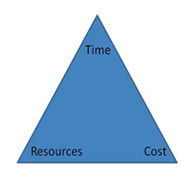Before the onset of the economic downturn and the meltdown in the financial sector, for businesses addressing change meant adapting to more cash coming in and what to do with it to keep investors happy or adapting to unprecedented growth – one of those “good problems to have”. Organizations were looking at 3, 5, and 7 year strategic plans with upwards of 20% growth year over year. A company doing $100 million in revenue might have had plans to double in size in four or five years.
As businesses were growing, building their customer base, and hiring, they may also have been planning to implement lean manufacturing or otherwise improve a host of business processes, from financial and R&D to product management, sales, and marketing. Along with the business processes improvements, IT managers were retooling their IT systems, upgrading their infrastructures, improving performance and security, or adding functionality for a host of business users.
But as the recession took hold the optimistic forward-looking projections changed. Revenues dropped precipitously and survival tactics were implemented across the board. Companies cut their work forces. Cost centers like Finance, HR, and IT gave up headcount. Even R&D headcount, usually the last to go, was reduced. New products in the pipeline were pared to the bare minimum. Manufacturing shut down to reduce WIP and labor costs. Purchasers cut orders to reduce inventory. Marketers cut back on tradeshows and direct campaigns, redirecting scarce funds to less costly online programs. Sales organizations were consolidated, products heavily discounted, and travel budgets reduced. Across the board employees were furloughed and salaries were cut. Performance-based bonuses were first severely cut and later completely eliminated.
At the same time that companies hunkered down in survival mode, the business environment continued to change. Markets changed, customers changed, and financial or other regulatory requirements changed. Technology changed as well. Prior to the current economic downturn, Oracle expanded its Cloud offerings. SaaS, PaaS, and IaaS have become more popular and while on-premises software is still a somewhat prevalent element, in many cases, it is becoming a legacy system. Despite the changes and even with significant loss of headcount, IT managers somehow continued to deliver and support IT to their internal or external customers.
Below we examine how the economy impacted five key business metrics: Productivity, Inventory, Days Sales Outstanding (DSO), Customer Satisfaction, and Retention, how organizations responded as the recession unfolded, and the effects they had – or should have had – on ERP systems.
Productivity
In order to reduce operating costs, virtually every department in every industry (except possibly health care and high-tech companies) experienced at least one Reduction in Force (RIF) during the recession. For everyone this meant doing more with less. Management’s expectation was that the remaining employees would become more productive. In some cases tasks were reprioritized with less important ones; those adding little value were eventually dropped.
There are many factors that contribute to a loss of productivity including reconciliation of multiple spreadsheets, manual adjustments, inconsistent data, a lack of standards for charts of accounts or calendars, or repetition of the same task across different parts of the organization. For Finance teams with reduced headcount, any processes that require manual entries or consolidating data in spreadsheets and then reposting is an inefficient and painful process that needs to be repeated on a monthly, quarterly, and annual basis. If a company uses more than one Chart of Accounts, for example, consolidating the data for reporting is problematic. Every account and every subledger needs to be mapped and reconciled manually, and many adjusting and intercompany entries need to be created. If different business units are operating on different calendars (month-end versus 4-5-5, for example), consolidating balances is also difficult. If there are multiple instances, there is even more effort involved in gathering, normalizing, and reconciling the data. If a company is operating a shared services center and the data entry team has to log into and out of different responsibilities for different operating units to do a check run, there is a significant loss of productivity. Consolidating instances, migrating to a single COA, standardizing on a single calendar, or merging operating units would significantly improve the team’s ability to produce accurate and timely reports and make decisions based on the entire company’s data without a host of manual workarounds.
It is no surprise that standard processes and data greatly enhance productivity throughout the organization. From data entry to analytics, there are significant gains that can be recognized by everyone in the organization understanding the data, using it in the same way, having a single, reliable place to get the data, and having consistent business processes.
Let’s look at some simple math. If a company has 10,000 items in inventory and three instances and they want to do a price change, they will need to update 30,000 items – three times as much work for a relatively simple task. They have to apply patches, backup, and maintain three databases. If a company uses two charts of accounts, then the company needs to create two sets of reports, two sets of financials, and two different rollup groups and hierarchies – twice as much work for every process – never mind the additional work of reconciliation and consolidation. No matter what the object is (instance, chart of accounts, calendar, etc.), when there are more than one, there is extra effort involved, extra time, extra complexity, extra cost, and reduced productivity.
Now, that’s not to say that a global company can operate with a single ledger or one operating unit. However, most EBS environments can be greatly simplified to reduce costs, comply better with statutory requirements, and be more manageable in the event of a RIF.
Inventory
For many organizations, during the previous economic downturn the first sign that the economy was in trouble was in their order numbers. During the COVID-19 pandemic we saw a steep decline in sales in the auto and retail sales, and increase in healthcare, food and household staples. Driven by the unprecedented global pandemic, the ability to effectively react to unexpected disruptions has fast become the most important commodity in logistics. Effectively managing inventory and quickly responding to changes in sales and orders requires systems that contain good data that can be easily and quickly accessed by demand management and purchasing. Lack of a solid inventory handling system can bring up problems which we previously noticed companies faced in the previous recession such as losing millions of dollars due to duplicate items, inability to consistently report inventory, and improper inventory organization which led to incorrect orders or tedious correction of bills and reports. For EBS customers, many of these problems can be solved by merging inventory organizations, resolving duplicate data, and restructuring the material handling, overhead processing, material overhead, outside processing, and expense costing accounts for sub-inventories as well as reviewing supplier terms across operating units.
Operating consistently and with a good source of data significantly reduces inventory costs, allows for better planning and just-in-time delivery of goods, better use of storage, more profit, and most importantly, better service to customers who know if an item is in stock. Good data and consistent processes are paramount to reducing costs – and not only in bad economic times. Although making changes to the data can be costly and time consuming, the cost of excess inventory and WIP can be far greater.

Days Sales Outstanding
Days Sales Outstanding (DSO) is the ratio of Accounts Receivable to Average Daily Sales. DSO is really a measure of how well Order Management, Inventory, Billing, Receivables, and General Ledger work together. There are many challenges to improving the order to cash process and thus reducing the DSO. Fragmented databases, a lack of visibility into the sales pipeline, multiple entries of sales and orders, and different revenue recognition rules within an organization all add days to the time between when an order is taken and when the cash is received. Streamlining the order to cash process may mean correcting or improving customer information (removing duplicates, enforcing consistent credit limits, invoicing correctly, and ensuring shipping and billing information is correct).
The ability to order across different inventory organizations or invoice across operating units can significantly improve DSO. An energy company using EBS had different operating units for their oil and gas lines of business. That meant that a customer subscribing to both services received two different statements a month and that there were different payment histories. There wasn’t visibility into the customer usage patterns – they didn’t even know which of their gas customers were also oil customers. After merging the operating units, they significantly reduced their DSO.
Having a single chart of accounts can improve the efficiency of receiving cash. Using Multi-org Access Control (MOAC) along with secondary ledgers enables timely enterprise reporting and analysis of DSO across operating units without going through a full financial consolidation or translation among different ledgers with different charts of accounts. Improving the receivables process, whether by improving the quality of customer data or consolidating instances or organizations so that there is a single consistent view, can have an immediate positive effect on cash flow.
Customer Satisfaction and Retention
Customer satisfaction is allowing customers to buy in the way that they want to buy. Retention is providing existing customers with an incentive to continue to purchase from you instead of buying from your competition. Obviously, during a RIF, a company needs to look at how they can provide products to their customers in the most efficient way and still have the flexibility to allow variations in customer buy patterns. A recent example of this during the COVID-19 pandemic is that a lot of restaurants in the country are able to retain customers and avoid laying off their staff by not outsourcing the delivery and providing their own home delivery service.
Banks and financial institutions focused on retention by offering an array of programs such as fee waivers, deferred payments and other accommodations to help their customers depending on their circumstances.
It is of utmost importance to maintain communication with your costumers so that they know that you stand with them and a great way to do this is to build a strong social media presence. Technology, like telemedicine and video conferencing software, has made it possible for many businesses to continue connecting with their existing customers virtually. For example, some gym instructors and nutritionists have started offering virtual services over video chat, walking their clients through home workouts and diet plans. Analyze your business to see how you can use technology to continue supporting your loyal customers remotely.
Conclusion
Productivity, Inventory, DSO, Customer Satisfaction, and Retention are five key business metrics that are affected by economic instability and require strategic and tactical responses by management. Managers typically respond by cutting costs, reducing headcount, and reorganizing. Overtime inventories are slashed, and product lines reduced. But with reduced headcount, the pressure on remaining employees to perform has increased. Nevertheless, the pressure will continue to grow until confidence in the economy and available credit improve enough for employers to begin hiring again. Employees will begin closely examining, if they have not done so already, any and all of the manual workarounds they perform every day, week, month, and quarter and demand improved performance from their ERP systems. IT managers will have a singular opportunity to support their organization by improving its existing EBS so they – and the economy – can begin the inevitable recovery process.
You may be taking a hit everywhere, but you can streamline your Oracle E-Business Suite to recognize immediate cost savings and to increase your revenues and profits.






